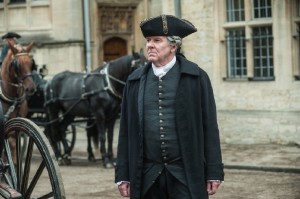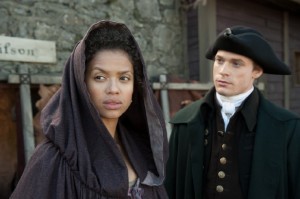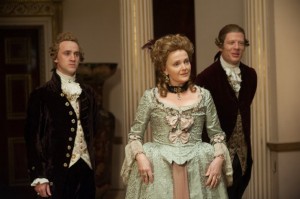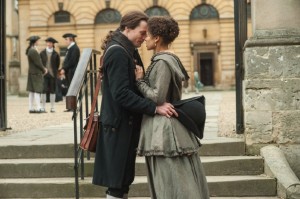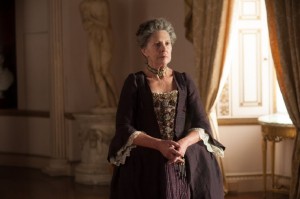Belle **** (2013, Gugu Mbatha-Raw, Tom Wilkinson, Sam Reid) – Movie Review
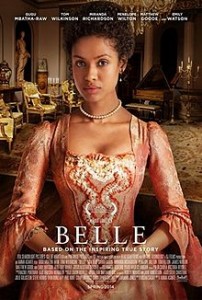
Gugu Mbatha-Raw stars as Dido Belle, the illegitimate mixed-race daughter of a Royal Navy officer, brought as a child to England by her father Captain Sir John Lindsay (Matthew Goode), who leaves her in the care of his uncle, top judge Lord Chief Justice Mansfield (Tom Wilkinson), and aunt at their Kenwood House estate.
Mansfield raises Dido as a part-outsider but still an aristocrat alongside her cousin Lady Elizabeth (Sarah Gadon). As an adult, Dido’s relationship with fiery, romantic idealistic young lawyer John Davinier (Sam Reid), a mere clergyman’s son, is opposed by Mansfield and his wife Lady Mansfield (Emily Watson) who try to match her with Oliver Ashford (James Norton). Oliver is one of the sons of Lady Ashford (Miranda Richardson), who wants Elizabeth to marry her penniless and nasty, racist older son James (Tom Felton). Ironically while Elizabeth has no money either, Dido receives a large inheritance from her father.
Meanwhile, Mansfield is deliberating on a slavery case, and the potential ramifications of the Zong massacre of slaves aboard a ship, a case that, with the right result, Davinier hopes will advance the cause of the abolitionists.
This is a lovely, sumptuous, gorgeous-looking film, telling a rattling good story. It successfully mixes social comment, historical detail, romance and Jane Austen-style gossipy characters and scenes, with the all-important social conscience issues of race and slavery. No doubt courting the Downton Abbey fans, it puts a glossy spin over it all, but treats it fairly and intelligently, as well as entertainingly.
Mbatha-Raw gives a strong, firm, understated performance of great dignity, and Wilkinson steals the film in one of this fine actor’s greatest, most faultless performances, perfectly judged, layered and graded. All the other actors are ideal too, with Reid splendidly fiery and romantic, Richardson nice and bitchy, Watson wise and friendly, and Penelope Wilton especially warm and effective as the spinster Lady Mary Murray.
Amma Asante was hired to re-write an original screenplay written by Misan Sagay, who left the film due to serious ill-health. Asante was originally named sole writer as well as director, but arbitration by the Writers Guild of America decided Sagay provided the bulk of content so Sagay was awarded sole writing credit. Wilkinson and co-star Penelope Wilton expressed ‘incredulity’ at the decision because they had ‘only seen and worked from a script written by Amma’.
The film is said to be based on a true story but in reality it’s a work of historical fiction, inspired by a 1779 painting attributed to an unknown artist as well as the historical evidence that Dido was brought up at Kenwood. Now hanging in Perthshire’s Scone Palace, the painting was one of the first European portraits to portray a black subject on an equal eye-line with a white aristocrat.
The lack of many hard facts about Dido Elizabeth Belle gives screenwriter Misan Sagay artistic license to frame her story in the historical context of a slave-supported economy and Empire in its death throes.
Belle is shot on location in the Isle of Man, Oxford, and London (especially Bedford Square). It is the first major British movie to be shot on true-4K, using Sony’s F65 CineAlta digital production camera. And it looks a treat in Ben Smithard’s cinematography.
The only quibble: Rachel Portman’s soupy and derivative score is OK, but it needs to shut up in the key serious moments, like Captain Lindsay’s speeches at the start and Mansfield’s court judgement on the slavery issue at the end.
(C) Derek Winnert 2014 Movie Review
Link to Derek Winnert’s home page for more film reviews: http://derekwinnert.com/


